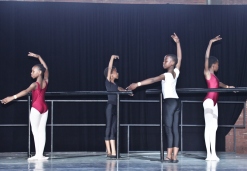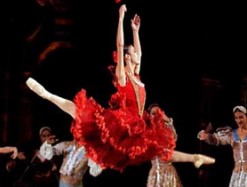
Taking ballet to township kids
When it comes to the arts, Dirk Badenhorst, the chief executive of South African Mzansi Ballet (SAMB), does not believe in social barriers. Instead, he believes that talent is talent no matter where it comes from, which is why SAMB has set up a development programme in the townships of Gauteng. Through this initiative, it offers classes […]


When it comes to the arts, Dirk Badenhorst, the chief executive of South African Mzansi Ballet (SAMB), does not believe in social barriers.
Instead, he believes that talent is talent no matter where it comes from, which is why SAMB has set up a development programme in the townships of Gauteng. Through this initiative, it offers classes to underprivileged children.
The SAMB Development Programme runs ballet schools in townships, where classes are attended by talented children from disadvantaged backgrounds. The children learn the art of ballet, at no cost to their parents, by professional dancers, who are paid a salary. There are schools in Soweto, Tshwane, Braamfontein, Alexandra, Sophiatown, Mamelodi, Eersterus, Katlehong and Melville. At these schools, more than 500 dancers, aged five to 16, are taught afternoon ballet classes.
Exposing children to a new world
“The programme provides a safe and well-adjusted environment for children to grow socially. It also introduces them to the joy of classical ballet while exposing them to a potential career in the performing arts,” says Badenhorst. “Another primary focus is to teach children from previously disadvantaged backgrounds valuable etiquette and leadership skills

through the art of dance, as well as exposure to role models. Once in the programme, children are instilled with a feeling of pride and self-worth through artistic performances.”
The school also selects youngsters to receive sponsorships to attend SAMB’s annual Winter School, where they are able to socialise with children from other studios. Students are also enrolled for annual examinations, through which they can get a formal Cecchetti Society qualification.
In 2012, five children from the development schools successfully auditioned to study at the National School of Arts in Braamfontein, Johannesburg; others have joined the Johannesburg Youth Ballet.
Cuban ballet school opens
Also in the ballet world, the South Africa Cuban Ballet School has started its new year and has opened its doors to the public for auditions. The school was initiated in 2012 following a partnership with Cuban ballet in 2008. The internationally respected Cuban ballet training system has produced many acclaimed dancers, such as Carlos Acosta, NorMaria Olaechea, Claudia Monja and Luis Bermudez de Castro.
Over the past four years, the Cuban ballet revolution has electrified the art in South Africa, re-energising dancers, teachers and audiences and taking ballet in South Africa to a new level.
“For many years, Cuban ballet dancers have infiltrated ballet in many parts of the world. That is why I wanted to bring it to this country,” says Badenhorst. “It has played an increasingly central role in ballet in South Africa.”
Cuban training methods
Training of dancers is done on a rotational basis by visiting ballet teachers from the National Ballet School of Cuba. “The activities of the new training project will not only benefit South African dance students but also South African teachers, who will have the opportunity to be trained in the Cuban teaching methods,” Badenhorst explains.
Ballet training includes the Alicia Alonso method, which is Cuban, and Vaganova, which is Russian but used in Cuban teachings. Cuban ballet has a romantic feel and combines Russian extension with fancy Italian foot work. Vaganova emphasises dancing with the entire body, promoting the harmonious movement of arms, legs, and torso.
“Overall, Cuban ballet appeals to audiences because it is sexy, passionate and full of prowess,” Badenhorst says. The guest teachers from the National Ballet School of Cuba this year are Ana Julia Bermudez de Castro, Elena Cangas and Martha Iris.
The South Africa Cuban Ballet School is offering three levels of teaching, providing for the training of students in three age groups: eight to 10 (level one), 11 to 13 (level two), and 14 to 18 (level three). The school operates every weekday afternoon at the Dance Factory in Newtown from 3.30pm to 6.30pm.
Each dancer trains four afternoons a week, leaving one weekday afternoon as well as Saturdays to work with teachers in other training methods and curriculums. The classes are 90 minutes and boys and girls are trained separately.
Vocational school for job creation
Badenhorst is largely supportive of entrepreneurship and creating jobs for his dancers, which is why it is envisaged that this training initiative with the Cuban teachers will develop into a vocational school, nurturing dancers into the professional company at SAMB.
“My ultimate goal is to have a proper system that focuses on vocational training in preparing dancers for professional stages,” he adds. “I want these children and the rest of our dancers to be able to go out in five years and get jobs, either in South Africa or overseas, or start their own companies.”
By: Cadine Pillay
Source: www.mediaclubsouthafrica.com
